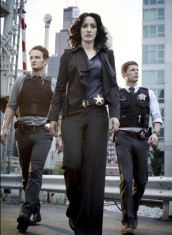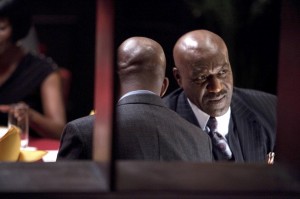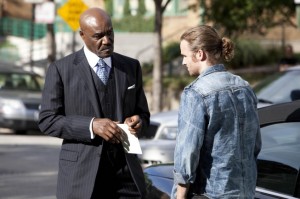
Billy Lush and Delroy Lindo in THE CHICAGO CODE - Season 1 - "Black Hand and the Shotgun Man" | ©2011 Fox/Jeffrey Garland
THE CHICAGO CODE was a wonderful, unconventional police drama, created by Shawn Ryan, which ran its full thirteen-episode arc this year on Fox and then was canceled. Tim Minear, one of the show’s executive producers/writers who worked with Ryan last year on FX’s arguably even more wonderful TERRIERS, gives us an exit interview on CODE about how it worked and where it might have gone had it lasted another season.
ASSIGNMENT X: How far ahead of the final episode airing did you know that CHICAGO CODE was not coming back?
MINEAR: We didn’t really know officially until around the time that it aired.
AX: Given that CHICAGO CODE’s ratings by, say, NBC’s standards were pretty good, did you guys ever think, “Maybe we should have taken it to a network where this would have been more appreciated in terms of what its ratings?”
MINEAR: You can sort of never second-guess these things. The truth is, I’m not sure it would have fit with NBC. I’m not entirely sure it fit with Fox, to be honest with you. It really felt almost like a CBS show, in a weird way. Like BLUE BLOODS or something.
AX: How did Fox break the news of the CHICAGO CODE cancellation to you and the staff?
MINEAR: I’m sure Shawn got a phone call. They broke it to Shawn and then Shawn emailed the rest of us.
AX: Was anything tweaked to make the last episode a series finale, rather than a season finale?
MINEAR: No. In fact, we went into it wanting to have a big finale for the big main Gibbons [Delroy Lindo] story for the season. That was the plan pretty early on. Never cracking that with the thought of not coming back, but probably in the back of my mind, I’m always thinking that, if you look at pretty much everything I’ve done, by episode thirteen, [have a solid season finale] just in case … [laughs] I try not to leave too many questions hanging, but we had plans for a second year. Gibbons wasn’t going to be out of the story. Doing that story in thirteen episodes gave you a pretty crackling, great last couple of episodes and his character, after having been arrested and the grand jury indictments, could make a great story in the next season.
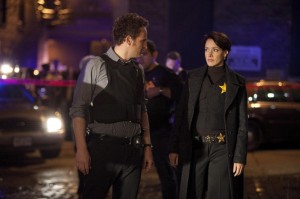
Jason Clarke and Jennifer Beals in THE CHICAGO CODE - Season 1 - "Black Sox" | ©2011 Fox/Jeffrey Garland
AX: What else was going to happen in Season Two?
MINEAR: We probably would have had Teresa [Jennifer Beals] and Jarek [Jason Clarke] move onto their next big challenge. We’d get a little more into the political fight probably, because of the prosecution of Gibbons, but at the end of the day, it’s still a cop show, so there would still be episodic stories on the street, and we would have continued pretty much as we had the first season. I like to think that we would have been more like the last six episodes than the first six episodes, where things maybe got a little bit more serialized. That’s what I would like to think.
AX: What was going to happen with Liam Hennessey, the undercover cop played by Billy Lush?
MINEAR: I don’t think we’d actually made a determination about that character’s future by the time the show went down. We had talked about killing him for the longest time during the first season as we were writing stories, but we kept him alive, because we all really liked the actor. It did feel like you didn’t want to play DONNIE BRASCO a second time with this guy. The notion was that we could bring in characters like Liam in subsequent seasons in different ways. It didn’t always have to be an undercover cop, although that may have ended up being a staple of the show on some level.
AX: Did you know what was coming up in Jarek’s domestic situation in Season Two?
MINEAR: We hadn’t really fleshed any of that out. I don’t think just because you see Jarek back with his fiancée in the finale means that’s going to proceed apace. As is often the case with network television, the incredibly interesting actress, Amy Price-Francis, who played Jarek’s ex-wife, became unavailable to us, because I think she got a Canadian series. So he may have ended up back with his ex-wife by the end of the first season had the actress been available. So you just don’t always know where you can go.
AX: As far as the fallout from Jarek’s brother’s murder, were there going to be any plot strands of finding any other people responsible, or was he pretty done with that?
MINEAR: That’s something we could have returned to. There was a lot of debate in the writers room about whether we should lean into that in the first thirteen episodes. I will say in my favor that I was probably the most vociferous about just really making the last couple episodes as much as possible about Jarek and his dead brother. We could have strung that out over a couple of seasons. I think we would have found some place else to go, because we kind of did spend that coin.
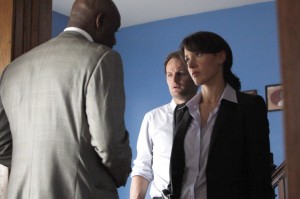
Jennifer Beals, Jason Clarke and Delroy Lindo in THE CHICAGO CODE - Season 1 - "Hog Butcher" | ©2011 Fox/Jeffrey Garland
AX: Was CHICAGO CODE done filming before any of it had aired?
TIM MINEAR: Shot but not finished. In other words, we may have been finishing shooting a few things, we were definitely still editing and doing post, but we did most of the shooting before we started airing.
AX: Was there any retooling before or during the run of the series?
MINEAR: I’ve been involved in other shows that have had actual major surgery in pilots and rethinking concepts. In this case, there was none of that. Literally, we looked at the first couple of episodes and said, “Oh. This moment should be early, then we should have a moment like this.” It was like three surgical strikes, very simple, in rearranging the original pilot. And the same way for the second episode that had been shot, and then, because we were mid-season, we were getting ready to write and break episodes nine and ten, and we had the opportunity to make them early episodes. In other words, we took nine and ten in the production schedule, and moved them into the three and four slot. So we were able to then front-load the first, say, six episodes with the mission statement of what we discovered the show was by the time we got there.
So nothing changed in the DNA of what we were doing. We were shooting far enough in advance that we could actually be making episodes and not worrying about when they would air, we could look at the half-dozen episodes that we’d made and we felt, “Okay, there are a couple of pieces missing earlier in the series.” For instance, one of my episodes, “Cabrini Green,” and I think the episode that came right before [“Gillis, Chase & Baby Face”], a Davey Holmes episode, were shot in the nine and ten slots on the shooting schedule, but aired as three and four. We just felt like there were a couple elements in those two episodes that we were missing in the early going of the episodes, so we essentially retrofitted a couple of episodes to go earlier. This is not a case of the network airing things out of order, this is a case of us having five episodes left to write and produce and realizing that we could take two of those episodes and write them as earlier episodes in the sequence, and buttress some of the elements that we felt were missing.
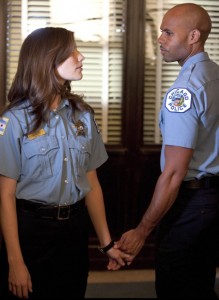
Todd Williams and Devin Kelley in THE CHICAGO CODE - Season 1 - "St. Valentine's Day Massacre"| ©2011 Fox/Justin Stephens
AX: Were you experimenting in a couple of episodes with making them little more stand-alone?
MINEAR: Yeah. That’s pretty much how we roll, you know what I mean? Whether it’s ANGEL or TERRIERS or CHICAGO CODE, you want to keep the main season’s story alive, but particularly in the early days of series, you want to have the show be something that a new viewer can enter for several episodes, so you want to make sure that you have stories that are a little closed-ended, but again, keeping the arc alive. So it’s a choice, but it’s also I think standard operating procedure.
AX: CHICAGO CODE was an unusually cohesive, fully-formed series from the outset. How did that come about?
MINEAR: This is something that Shawn Ryan had his head. Shawn is from near there, and he’s done a ton of research, and I think this had been cooking in his head for a long time. In terms of the elements feeling of a piece, I would say that’s a function of all of us as the writing staff just being in the room and just doing the hard labor of banging out the story beats. Research was something that Shawn was really adamant about. There’s always some Chicago [reference] about the titles of the episodes. They might not seem to apply to the episodes themselves, but if you looked a little further, you’d find that they always do. So this was something that we researched.
And then we had John Folino, who was our Chicago police technical advisor. We got a lot of stuff from him. John was invaluable in every way imaginable. You could just sit there and talk to him about his life as a detective, and hear about how it really works, which would just spark a million different ideas for stories. And his [script] notes were always, “We would say this, not this,” or “This is how this would really work.” We would get the technical stuff, but then we would also get story ideas from just being around him and hearing what he had to say, and sometimes, we would be wanting to go down a certain track with a story, and we would call him and start talking out a story idea with him and saying, “Is this possible, would this work?”, which would then spark with him actual incidents from his actual experience, or someone else’s actual experience. It really made all the writers feel safe. I know he made the cast feel safe, because he would be there on the set [to answer questions] like, “Would a cop hold his gun like this?”
AX: Were there any elements of CHICAGO CODE that popped for you as you were watching them?
MINEAR: I would say Delroy Lindo is just incredible. That’s one of the reasons we actually made “Cabrini Green,” because you see him and you’re like, “How about an episode that has more of him?” because he’s so awesome. [During production] Delroy was saying, “I never thought of him as a bad guy.” He actually kept us very honest. There was some good back and forth tension between him trying to protect that character as an individual and us as writers kind of wanting to go to the easy villainy place, just because there’s a certain amount of economy with which you need to tell a story in television, so if you’re too subtle, the audience is going to get restless or whatever. That character, to my mind, not only does not think he is evil – I’m not sure he is evil. I think he is an idealist rather than a pragmatist. I really think that he sees himself as making people’s lives better. Any politician who has any measure of success has a good amount of self-promotion and ambition, and he certainly has all that, but I believe that you can look at almost everything he does and say it could be for noble reasons or for self-promotion. You can do things that are self-promoting and completely talk yourself into the nobility of what you’re doing, even if you’re lying to yourself.
AX: How far was Season Two mapped out overall?
MINEAR: I don’t know far Shawn had mapped it out. We talked about it sort of in generalities. I do know that there were some meetings right before the network made the decision whether or not they were going [to continue the series] where Shawn met with the rest of the writing staff. I did not attend those meetings, because the studio had me helping out over at TERRA NOVA. So I don’t know exactly what they came to the last day in the writers room.
Follow us on Twitter at ASSIGNMENT X
Fan us on Facebook at ASSIGNMENTX
Let us know what you think – leave your comments below.
Click on link: AX’s exclusive interview with Tim Minear gives the scoop on AN AMERICAN HORROR STORY and TERRA NOVA
Click on link: AX’s exclusive interview with Tim Minear on DOLLHOUSE and what Season 3 could have been
Click on link: AX’s exclusive interview with Tim Minear on the end of TERRIERS
Click on link: AX’s exclusive interview with Tim Minear on DRIVE
Click on link: For AX’s The Chicago Code series finale review – “Mike Royko’s Revenge”
Click on link for AX’s exclusive interview with CHICAGO CODE star Jason Clarke
Click on link for AX’s exclusive interviews with CHICAGO CODE stars Devin Kelley, Todd Williams and Billy Lush
Click on link: For AX’s Complete Season 1 The Chicago Code episode reviews
CLICK HERE for AX’s exclusive interview with CHICAGO CODE star Delroy Lindo
CLICK HERE for more exclusive CHICAGO CODE reviews and news
Related Posts:




